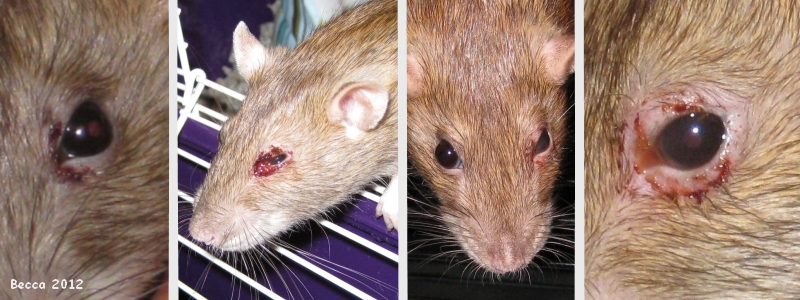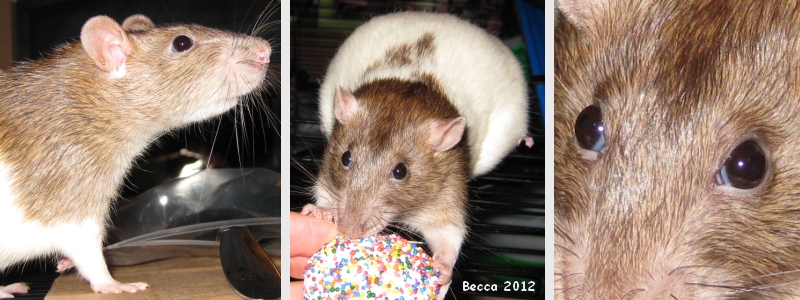Figure 1: Infection of the left eye in female rat (Ellie).
Case history and photo
History
Ellie (agouti hooded female rat) was obtained from a pet store that breeds its own rats; the breeding is focused on personality. Ellie was born mid-July 2008.
Ellie, her sister, and later also two younger female rats are housed together in a large rat cage. Every level contains a litter box with aspen in it; the floor of the cage is initially also lined with aspen. All the bedding consists of fleece. Ellie and her sister are litter box trained. Any additional puddles of urine found on cage shelving are wiped up several times a day.
Ellie has a history of respiratory issues and “teary eyes” (porphyrin). Several types of bedding material are tried in an attempt to decrease the symptoms; aspen seems to work well for her.
In December 2009 Ellie’s respiratory problem, again, becomes noticeable. Around Christmas-time her sister passes away. At first the sneezing and tearing appear to resolve, but when these signs resume once again on 4 January 2010, both eyes are gently flushed with a lukewarm saline solution. The tearing subsides, but some sneezing remains. A few days later a “popcorn noise” is heard coming from Ellie’s lungs. She is taken to a veterinarian, who diagnoses her with pneumonia and puts her on oral Baytril. It is assumed that the stress of losing her sister is a factor in causing Ellie’s respiratory problem to worsen.
By 18 January, Ellie has improved considerably.
On 28 January, Ellie undergoes surgery for a large mammary tumor. The surgery and recovery are uneventful. Shortly after the surgery Ellie is happily running about again.
Clinical Signs
In the meantime, Ellie’s left eye has continued to tear (note that she is still on oral Baytril). The impression is that there is something in the eye-socket, rubbing against the eyeball and irritating it. The eye is flushed out on several occasions. After flushing it looks normal for one or two hours, then the tearing returns. There is in fact so much tearing that the left eyelids are occasionally “crusted shut”. The porphyrin crusts are removed by placing a warm wet cloth against the eye; however, within 30 minutes the eye is once again crusted up.
On 1 February, Ellie is taken to the veterinarian to be seen.
Diagnosis
Eye infection.
Treatment
The vet prescribes Tobramycin Ophthalmic Drops (an aminoglycoside), to be applied to the eye a few times a day. Note that application is occasionally hindered by the fact that the eyelids do not open far enough.
Separating Ellie is briefly considered, especially when one of her cage-mates is observed licking Ellie’s eye, helping her remove the crust. However, Ellie becomes very stressed and unhappy when she is removed from her large cage and cage-mates. There was no sign that the infection was spreading to her cage-mates.
Follow up
Initially, the left eye becomes increasingly cloudy. On 2 February the pupil has become less visible. When there is no tearing around the eye there appears to be a “film” on the eye that moves as Ellie opens and closes it. In addition, the left eyelids show a “red ring” of soreness, and Ellie continuously scratches at the eye. (Note that she also scratches a lot at a spot slightly behind and underneath her left ear; however, after putting some olive oil on the skin in that area, the scratching ceases.)
On 4 February, Elle appears quite unhappy. As she has been somewhat constipated, the oral Baytril is stopped (the respiratory problem has improved, and it does not appear to be effective against the eye infection).
On 6 February, Ellie appears to be feeling better. The left eye is less cloudy and the pupil is once again visible. However, although Ellie does use her left eye to “look” at her keeper when she calls for her, the remainder of the day she keeps the eye closed.
By 10 February, the eye looks less sore and there is less tearing. However, Ellie appears quite agitated: she attempts to tear up all the fabric (hammocks and beds) in the cage, does not want to be held, and does not want to be near her cage-mates. The following day Ellie’s keeper notices that her left eye appears “sunken in” compared to the healthy right eye. In addition, the inner corner of the left eye is red, instead of its normal blueish-grey color.
On the morning of 13 February Ellie’s left eye looks especially bad, making her keeper decide to flush the eye out half an hour prior to applying the drops. A short while later the eye has improved considerably: the eye seems to protrude more (closer to its normal position) and the color of the eyeball as well as the inner corner of the eye is returning to normal. The pre-application flushing is repeated during subsequent drop applications. Ellie’s keeper also increases the frequency of drop application to several times a day.
Unfortunately, Ellie starts “rubbing” at her left eye immediately after application of the drops. She can occasionally be distracted with a treat, but not always and not for long. Her keeper does not want to use an e-collar, because she feels it will cause too much stress for Ellie.
On 19 February Ellie is taken back to the veterinarian, as she continues to have “bad days” and “good days”, making it unclear whether the drops are effective or not. The vet applies fluorescent dye to Ellie’s left eye, but no scratches are observed in or on the globe of the eye. After taking a closer look at the eye, the vet reaffirms that it looks like a bad infection, which is simply not clearing up.
This time Terramycin ointment is prescribed. Ellie’s keeper initially has some difficulty applying the ointment, since Ellie refuses to hold still long enough. However, once she is successful, the ointment clearly remains on the eye longer than the drops did: it is still visible after two hours. The other important difference is that Ellie does not attempt to groom her face/eye after application of the ointment, as she did after application of the drops.
Outcome
Three days later there is already a noticeable improvement in Ellie’s left eye. By 27 February, although the eye has not resumed its normal protrusion yet, the color looks better and there has been no more tearing. By early March the eye has healed completely.
No further eye issues occurred during Ellie’s lifetime.
Interestingly, her respiratory problems also never played up again.
Photos
 The first photograph shows the initial minor porphyrin staining in the inner corner of Ellie’s left eye. The second photograph was taken when the situation had progressed to frequent tearing, with the eyelids occasionally being “crusted shut”. The final two photographs were taken on 12 February. |
 These photographs show Ellie prior to the eye infection, with a close-up of her eyes in their normal condition. |
Pet keeper: Rebecca (Becca) Scott
Photos courtesy of Rebecca Scott
Case history courtesy of Cyzahhe


